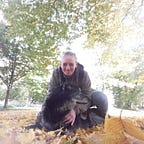The Future of Augmented Reality (part I of II)
Holographic Imaging for a Virus — Corona — Free World
By Maria Anna van Driel, www.nexttruth.com
Once our whilom Earth saw a primordial evolution whereby the coordinates of her oceans where in a location of being utterly different compared to their contemporary geographic coordinates. As the Earth slowly kept rotating, so did the tectonic plates. Slowly but certain the ocean floors became visible. Sea plants and microscopic animals (plankton) saw their habitat dwindle. Their dead was inevitable as they became exposed to the Earth’s primordial atmosphere and started to convert into, among others, several types of chalk.
Taking a quantum leap through time and space we leave the Jurassic era of a young Earth, quickly pass the Cambrian Explosion (the rise of animals), skim past human evolution and soon we are approaching, with the speed of 299,792,458 meters/second, a miracle year (1905) in where the mailbox of the German scientific journal Annales der Physik received four papers that would forever change the laws of physics and, ultimately, our conception of reality: of light, matter, time, and space.
But just before we glue our quarks together, rebuild our atoms and slide into this dimension of a new scientific revolution, we reduce the ‘exited state’ of the electrons swirling our atoms (aka ‘ground state’) what, eventually, slows us down, directs our momentum (p=Mv) and makes it possible for us to take our position in the year 1904, where, in a patent office located in Bern (Switzerland), a young man aged 26, was working as a clerk, who was two years prior on the verge of giving up on his dream of becoming a physicist. Albert Einstein.
But how can Einstein’s profound thought experiments and awe-inspiring research papers on time, space and light, turn into a magical and mind-blowing new technology called ‘virtual and augmented reality’? And, how can it catapult us from the (superficial) information age into an age of an augmented reality and secure our health?
Bending and blurring reality with holograms
The origins of holographic imaging in 2D are quite old and the thought of creating a 3D on a two-dimensional plane we see rising 1947, when British scientist Dennis Gabor developed the theory of holography while working to improve the resolution of an electron microscope.
Even though we do not lift an eyebrow anymore when hearing the term ‘holographic, ‘virtual living’ has become as real as the orange you are eating during lunch.
From virtual banking, to virtual learning, virtual travel, virtual shopping, virtual communication. and of course, virtual gaming, the combination of Artificial Intelligence (AI) with Augmented Reality (AR) and mixed reality, can provide an extensive application in biotechnology. Furthermore, it will enable an interaction of the digital with the physical environment in a multi-dimensional way that will help prevent, manage and cure billions of people.
Powerful tools with real-time AI integration
Several powerful tools have already being developed with the potential to redefine disease detection, diagnosis and treatment. Detecting cancer, Corona or any others lethal disease humanity has to contend with, through super cool image recognition can help medical doctors in their patients diagnosis with an amazing real-time screening analysis which are just as accurate as those performed by trained professionals.
For example, an AR microscope (a system consists of a modified light microscope fitted with a camera that captures the field of view) with real-time AI integration for cancer diagnosis overlays AI based information onto the current view of the sample in real time. Meaning, an AI based AR device can provide real-time holographic visualization of the patient’s actual anatomy to surgeons which they can use during simple or complex surgical procedures.
When applying an AR headset, what overlays specific information floating over the patient, surgeons are able to visualize bones, muscles and internal organs without even having to literally dive into the patient’s body.
Changing the world
The World Health Organization estimates that by 2035 there will be an approximate twelve point nine million shortage of health professionals and it is partly attributed to shortcomings in the execution access and quality of health professionals education. So, even it might scare some of us a bit but, virtual reality and augmented reality is a part of human evolution and will change the way that you see and feel the future world.
Now, we, as human individually, might not be mentally prepared for all this change yet. As a species, we have just started to crawl out of the cradle of evolution being convinced that, during the early years of the 1900th’s, it was a good idea to explore our infant knowledge concerning chemistry, and the reactions, when being merged with biological objects.
Not to mention that, several decades later, we started to focus our creative minds and refining our freshly gained abilities in creating novel machines like cars, trains, airplanes followed by accelerators, satellites and, eventually, space stations. This has, unfortunately, resulted in unnatural vibrations and radio waves which are a perfect ‘highway’ for primordial viruses, to travel on through both the Earth’s atmosphere and outer space.
Even though the above sound like the plot of a thriller like “The Swarm” written by Frank Schatzing, global warming, so many argue, might be caused by this and, in this line of thought, the true cause for why we currently experiencing this grisly pandemic.
So, whether you are talking, with your classmates, about inventions on the periodic table, computing, population…we are seeing a trend towards exponential change. And what this means is: what happened in the last 10 years has nothing to do with what can happen in the next 10 years.
And even if you understand this trend towards compound growth, if we don’t find ways to ‘visualize’ it, in the mind or holographic, it is going to be hard to change our way of thinking as a ‘jackpot generation’ and thus our way of living in the future.
The challenge is yours to tackle.
